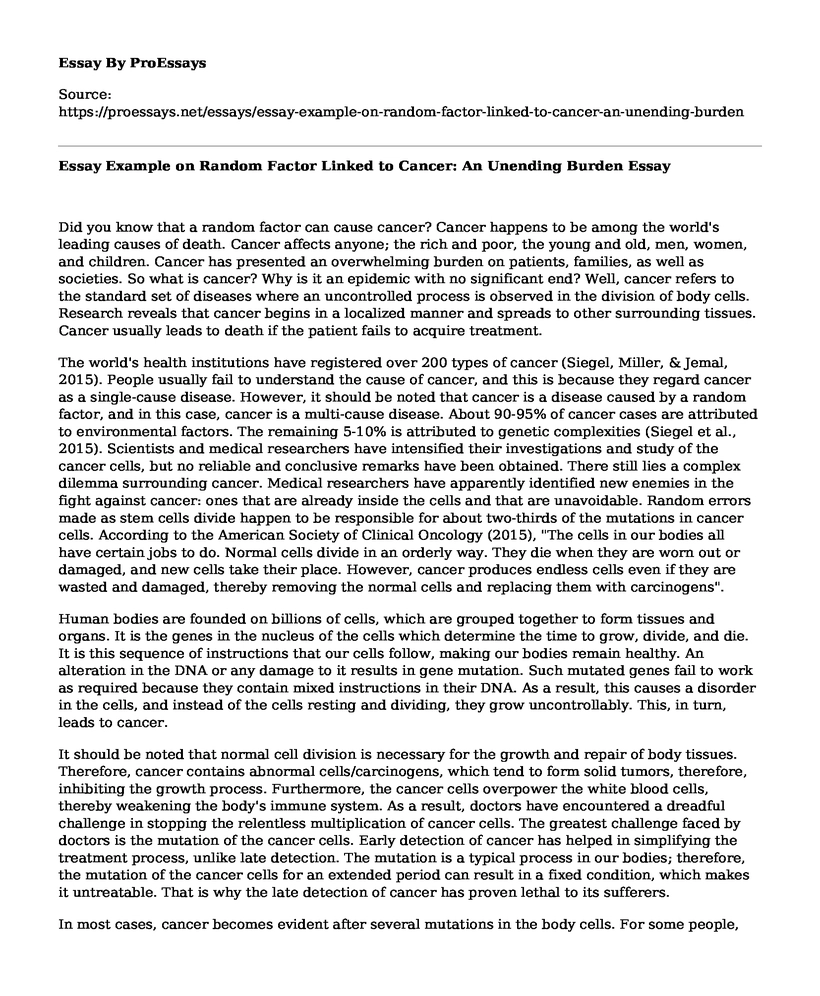Did you know that a random factor can cause cancer? Cancer happens to be among the world's leading causes of death. Cancer affects anyone; the rich and poor, the young and old, men, women, and children. Cancer has presented an overwhelming burden on patients, families, as well as societies. So what is cancer? Why is it an epidemic with no significant end? Well, cancer refers to the standard set of diseases where an uncontrolled process is observed in the division of body cells. Research reveals that cancer begins in a localized manner and spreads to other surrounding tissues. Cancer usually leads to death if the patient fails to acquire treatment.
The world's health institutions have registered over 200 types of cancer (Siegel, Miller, & Jemal, 2015). People usually fail to understand the cause of cancer, and this is because they regard cancer as a single-cause disease. However, it should be noted that cancer is a disease caused by a random factor, and in this case, cancer is a multi-cause disease. About 90-95% of cancer cases are attributed to environmental factors. The remaining 5-10% is attributed to genetic complexities (Siegel et al., 2015). Scientists and medical researchers have intensified their investigations and study of the cancer cells, but no reliable and conclusive remarks have been obtained. There still lies a complex dilemma surrounding cancer. Medical researchers have apparently identified new enemies in the fight against cancer: ones that are already inside the cells and that are unavoidable. Random errors made as stem cells divide happen to be responsible for about two-thirds of the mutations in cancer cells. According to the American Society of Clinical Oncology (2015), "The cells in our bodies all have certain jobs to do. Normal cells divide in an orderly way. They die when they are worn out or damaged, and new cells take their place. However, cancer produces endless cells even if they are wasted and damaged, thereby removing the normal cells and replacing them with carcinogens".
Human bodies are founded on billions of cells, which are grouped together to form tissues and organs. It is the genes in the nucleus of the cells which determine the time to grow, divide, and die. It is this sequence of instructions that our cells follow, making our bodies remain healthy. An alteration in the DNA or any damage to it results in gene mutation. Such mutated genes fail to work as required because they contain mixed instructions in their DNA. As a result, this causes a disorder in the cells, and instead of the cells resting and dividing, they grow uncontrollably. This, in turn, leads to cancer.
It should be noted that normal cell division is necessary for the growth and repair of body tissues. Therefore, cancer contains abnormal cells/carcinogens, which tend to form solid tumors, therefore, inhibiting the growth process. Furthermore, the cancer cells overpower the white blood cells, thereby weakening the body's immune system. As a result, doctors have encountered a dreadful challenge in stopping the relentless multiplication of cancer cells. The greatest challenge faced by doctors is the mutation of the cancer cells. Early detection of cancer has helped in simplifying the treatment process, unlike late detection. The mutation is a typical process in our bodies; therefore, the mutation of the cancer cells for an extended period can result in a fixed condition, which makes it untreatable. That is why the late detection of cancer has proven lethal to its sufferers.
In most cases, cancer becomes evident after several mutations in the body cells. For some people, they bear accumulated quantities of cancer mutations, but it will not be detected until some final insult goads the cell into becoming malignant. Other malignancies are a result of various combinations, including environmental, heritable, and random mutations. Lung cancer, as well as other tumor-type cancers, are connected to environmentally-caused mutations, although they can be prevented by totally avoiding the carcinogen. Cancer can also be avoided by adopting a diet to decrease the factor of obesity. Obesity has been seen to be among the lifestyles that lead to cancer. This is because obesity results in diabetes, which occasionally develops complications hence the growth of cancer.
Conclusion
In conclusion, doctors have gotten a cure for cancer through treatment. However, cured cancer may still revive in the body even after curation. As such, most of the doctors conclude that cancer is generally in remission instead of being fully cured. Remission simply means the presence of limited signs and symptoms of cancer. Cancer is a complex disease in which doctors and medical researchers have had a hard time-fighting. Until now, research institutions specifically dedicated to the study of cancer have been established to study the disease. Moreover, governments have taken the initiative to start cancer campaigns to create awareness in public. Cancer has proven to be a global epidemic that needs to be strategically fought in all directions.
References
American Society of Clinical Oncology. (2015, July). What is Cancer?. Retrieved from: http://www.cancer.net/navigating-cancer-care/cancer-basics/what-cancer.
Siegel, R. L., Miller, K. D., & Jemal, A. (2015). Cancer statistics, 2015. CA: a cancer journal for clinicians, 65(1), 5-29. DOI: 10.3322/caac.21254
Cite this page
Essay Example on Random Factor Linked to Cancer: An Unending Burden. (2023, Mar 26). Retrieved from https://proessays.net/essays/essay-example-on-random-factor-linked-to-cancer-an-unending-burden
If you are the original author of this essay and no longer wish to have it published on the ProEssays website, please click below to request its removal:
- Nursing Informatics Quality Improvement Plan - Essay Example
- Population, Health Behavior, and Underlying Reasons for the Behavior
- The Prevalence of Comorbid Depression in Adults With Type 2 Diabetes Paper Example
- Advances in Polio Vaccine Technology and History of Polio Vaccine Technology - Research Paper
- Essay Sample on Electronic Medical Records
- Press Release on Measles - Essay Sample
- Paper Example on ANA Code of Ethics: A Guide to Professional Practice in Healthcare







